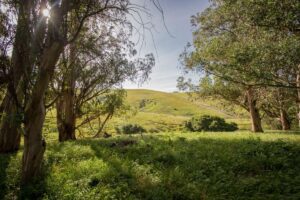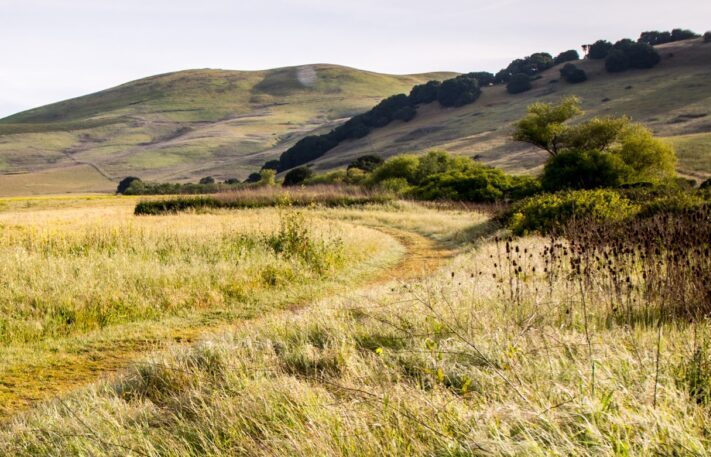Scenic Easements for the Jack and Bernice Newell Open Space
About the Property
The Jack and Bernice Newell Open Space is a 640-acre property donated by a long-time American Canyon resident. At one time slated to be a city landfill, this property – with its windswept hills, bay-oak woodlands, creeks, and grasslands – is now owned and managed by the City of American Canyon as a public open space, and protected through a conservation easement held by the Land Trust of Napa County. The Open Space lies outside the most rapidly growing city in the County. A key raptor migration corridor runs through the property, and most days of the year you can see such raptors as golden eagles, red tail hawks, white-tailed kites, and northern harriers on the property.

The Land Trust
The mission of the Land Trust of Napa County is “to protect the natural diversity, scenic open space and agricultural vitality of Napa County by preserving lands with significant conservation values for present and future generations and by fostering an appreciation and understanding of the natural environment.” The Land Trust is a nonprofit organization with over 1,350 members. The Trust receives no operating support from any government agency and is the only organization, either public or private, actively working to preserve open space and agricultural land in Napa County.
The Easement
When the landowner approached the City of American Canyon about the creation of a city park, the Land Trust stepped in to help out with transaction. The Trust and landowners worked together to create a conservation easement, rather than a scenic easement in accordance with IRS regulations, which the landowners donated to the Trust. The landowners subsequently donated the property to the City of American Canyon.
What Scenic Resources Does the Easement Protect?
The property includes a substantial portion of the viewshed for the eastern backdrop of the city of American Canyon. The property is also home to an important Coast Live Oak forest with many trees over 200 years old.

Key Scenic Conservation Strengths of the Easement
The drafters of this easement clearly understood that the property was to become a passive recreation area and crafted it accordingly. In doing so, several scenic conservation strengths emerged.
First, the easement prohibits the installation of new or extensions of existing utilities except to provide utilities to any future caretaker’s residence. While this 10-year-old easement predates the growth of wireless communications, the language in that clause effectively keeps cell towers and wind turbines off the property.
Second, the easement prohibits new construction, including construction for the support of passive recreation activities, from covering more than two percent of the property with impervious surfaces, including any structures, parking lots, paved trails, etc. This provision not only preserves water quality, but it limits the potential visual disruption of support facilities.
Third, while many parks, including passive recreation facilities, are often home to money-making events, the easement for this property limits such events to no more than three per year. While people seldom consider events as scenic disruptions, many parks have borne the brunt of excessive activity (effectively being “loved to death”) and some events have substantially scarred the land.
Potential Weaknesses of the Easement
There are two potential weaknesses in this easement from a scenic conservationist’s perspective.
First, while the easement prohibits placing signs or billboards on the property except for standard “for sale or rent” signs, signs announcing the easement, or information signs for passive recreation users, it places no limits on the size of such signs.
Second, for a parcel such as this one, and given the nature of the site and the plans for passive recreation and support facilities, there should be provisions guiding both the design of new facilities calling for them to be in keeping with the character of the site and the placing and design of lighting fixtures to limit potential light pollution.
Key Enforcement Clauses and Other Noteworthy Procedural Language
Opponents of conservation measures often seek language stating that if a governing body does not respond to an application within a certain time period, the project is “deemed approved.” This particular easement contains a provision stating that if the Trust fails to respond to a notice of a proposed activity requiring its approval within 60 days, the proposal is “deemed denied” unless the landowner sends a second notice by certified mail. If the landowner does so and 30 days pass without a response, then the request is “deemed approved.”
Conclusion and Assessment
This easement arose out of special circumstances, with the landowners planning to turn the property over to the city of American Canyon for use as a park and wanting to be absolutely certain that the city treated it right. With those plans and desires in mind, the Trust crafted a conservation easement that recognizes the needs of passive recreation and that, for the most part, protects the natural and scenic resources on the site. A possible improvement for the easement could include limiting light pollution, a growing scenic concern in the last five years. In general, the easement has served the property and its preservation goals well.
